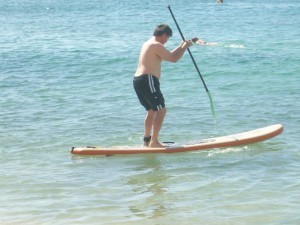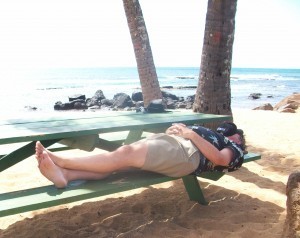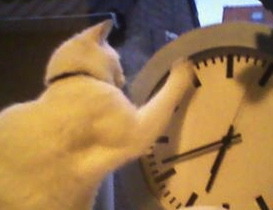Beverly Nault's Blog, page 13
March 6, 2012
Give me a break (with apologies to John Stossel)
The hubby and I recently took a much needed break (well, he needed one more than I, but a wife does what she can) to Kaua'i.
In my zeal to ensure we took full advantage of this lovely vaca, I may have started a few weeks early by singing out, "in six weeks we'll be on the beach in Hawaii" or "just think, we will be watching the sunset from our condo in three weeks…" when he'd get home from a long day at work.
Not sure if it helped, but I adore the islands.
And I may or may not like to tease.
So I thought I'd share some of the highlights of our trip with you.
We tried paddling. ("We" in the sense that Gary tried paddle boarding.) But that's for another post. As soon as I can write without maniacal laughter.
"Whoa."
"I'm ok!"
>maniacal laughter<
Pull yourself together Bev.
Ahem.
And we relaxed.
 And drove around the islands. This is in Lihue.
And drove around the islands. This is in Lihue.
Me: "Honey, do you want to try paddle boarding again?"
Him: "Mmft"
What did you do besides take pictures and lead everyone on the beach in laughing and pointing, Bev?
Why, thanks for asking!
 I joined in a death-defying zipping experience over former sugar plantations infested with man eating crocodiles. (Not. Actually the most dangerous part is walking from one launch to the next. Watch out for that pebble!)
I joined in a death-defying zipping experience over former sugar plantations infested with man eating crocodiles. (Not. Actually the most dangerous part is walking from one launch to the next. Watch out for that pebble!)
But you are up really high. Just sayin'.
The only downside to Kaua'i, and mind you I'm not complaining, are the chickens. (All right, I'm complaining a little.)
Oh boy, the legends, stories and myths abound about how they got to be such a fixture. But here's the bottom line. Chickens + no natural enemies = waytoomany. (Didn't know there would be math involved, did you?)
They are by no means endangered, trust me, but they are protected to a degree in that all "wild fowl" are, so the feral ones cannot be caught and served up in a luau or at the local KFC. Unless they roam onto your property… according to some sources. (Warning: they're quite tough and gamey. One resident told me this, but he didn't say how he knew.)
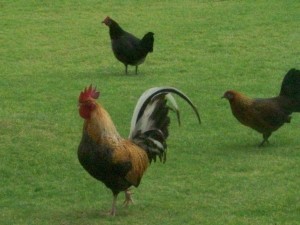 Seriously, there are TOO many. Especially the incredibly loud, and extremely close-to-your-windows-left-wide-open so you can enjoy the sound of the surf as you sleep ones.
Seriously, there are TOO many. Especially the incredibly loud, and extremely close-to-your-windows-left-wide-open so you can enjoy the sound of the surf as you sleep ones.
Oh, boohoo, Bev. Right?
They really are becoming a problem. They wander everywhere, get hit by cars (I think it's becoming a reverse frogger game by islanders). I have to imagine they compete with other, ahem, more attractive, birds for food.
Nor are they sacred, as one tourist sagely advised.
Give me a break. No one's worshiping them.
How did there get to be so many, and why protected? That's where the legends and myths come in.
Apparently, many years ago some species of wild chicken was introduced on the island, and after the barnyard fowl were released, possibly during a hurricane, they mixed and mingled, and now it's impossible to tell which ones carry the DNA of the more exotic birds and which are just, well, chickens.
They've become part of the fabric of Kaua'i.
And alas, a part of our memories, because now we're back on the mainland, recalling them, and everything else, with fondness. Well, everything else.
Me: "Remember how two weeks ago we were watching the sunset on the beach?"
Him: "Mmft."
It never gets old.
February 1, 2012
Live on purpose.
Recently, I read an inspiring book, Organized Simplicity: The Clutter-Free Approach to Intentional Living.
Author Tsh Oxenreider had me at "clutter-free." She makes SO many good points, practical and wise, about making a reality of the old advice, "don't let your possessions own you."
But it's so much more than that. She teaches to be intentional. To make life simpler, better, for you and your family.
Now I'm not a hoarder, or a big shopper…really I'm not! Ahem.
But one of my favorite possessions (we are allowed a few, right?), is a label maker. And I crave organization. Why do my spices need another label, you ask? 
Because I'm lazy. No pesky lifting and searching for that tarragon. (When's the last time that spice was used?) One of Tsh's most inspiring bits of advice. Labeling simplifies. Forces me to answer the question: where does this belong; is it useful?
Let me back up. Following Tsh's advise when cleaning clutter, I'm scrutinizing everything with, "Is it beautiful?" or "Is it useful?"
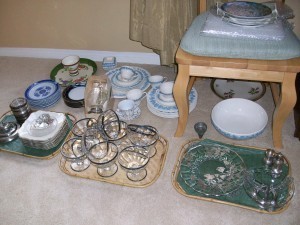 To put intention to action, I started with a china cabinet. Mostly inherited items, all beautiful, but rarely used. Off to eBay, garage sales, to someone who may find more value in items that have been dust gathering, forgotten.
To put intention to action, I started with a china cabinet. Mostly inherited items, all beautiful, but rarely used. Off to eBay, garage sales, to someone who may find more value in items that have been dust gathering, forgotten.
Consider this beautiful pitcher, never used by my mother-in-law, or by us. Still in the box. 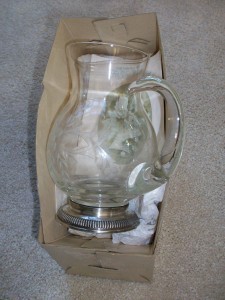
These heirlooms are easy to part with since they don't hold much sentiment beyond the shared monograms. Okay, I might hold on to the lovely silver bowl inscribed with an "N." (Until I have to polish it a few times.)
Next I'll move to a cabinet or closet that may be more difficult to work through. But I'm inspired to let go when necessary.
Beyond physical items, Tsh describes the value of evaluating activities for their value. Relationships. Even work situations. Time for a new job? Are your friendships meaningful, honest, or detrimental? Is your spiritual life worthy?
As you know, I'm all about fresh starts. (Shameless plug for my book.)
Maybe it's time for you to begin again in some of these areas.
Thanks to my friend, BethAnne, at Thrifty Living, for alerting me to Organized Simplicity and many other great thoughts on intentional living in her blog.
In closing, here's one of my favorite Tsh quotes:
"Put a stake in the ground as an ebenezer of remembrance that today, you are choosing to say no to unrealistic cultural expectations, and yes to the best life for your family." (Kindle, location 1436)
Now I need to find out what tarragon's useful for. Pretty sure it's not beautiful.
January 25, 2012
It’s complicated. Part II (or The road to publication)
Last time in this complicated series, we talked about my friend, Danny, who asked “What does it take to become a published author?”
I know you’ve been patiently waiting, so here’s my looong answer:
“Wow. First of all, learn to write really well. Whatever every English teacher has ever taught you becomes gold you will continuously mine. OK, maybe that’s an exaggeration, but spelling, punctuation, dialogue, story structure, and proper grammar are paramount. Next, practice, practice, practice. Keep journals, write articles and/or stories in long and short form. Read and study poetry, because they are excellent forums for learning colorful descriptions, analogy and flow. Also, read everything you can get your hands on, from newspapers, magazines, to classics, and current bestsellers. Oh, and study. Take classes from pubbed authors, attend workshops, conferences, etc. Be a student of life. Observe, watch, listen, notice smells, the way people speak…and then hone your skills to a genre or form to which you are drawn. When you have work to share, join a critique group (or two) and listen to what others tell you about your work. No rubber-stamping allowed, because no one improves by being told how wonderful they are! And when you get close to being ready to offer works for sale, the process becomes a business. Which becomes an entirely new discussion about pitches and marketing, platforms and branding, royalties, agents…you get the drift.”
Deep breath.
The short answer: Write a really good story. Really good. And if you can, write really well. (I say “if you can” because lately it seems to me that good story trumps proper style . That’s another episode, but certain bestsellers like >cough< Twilight >cough, cough< come to mind.
If Danny (or anyone) has the desire and drive to write, not even the mightiest of obstacles can stop you. Because like any art or passion, wordsmithing, storytelling, poetizing…the desire bubbles from within and must be released.
Pow!
So surround yourself with resources to hone your craft, see below.
And pray. Without ceasing.
After a quick survey of my bookshelf, these are the most dog-eared resources I keep handy:
Every book about writing by James Scott Bell. Seriously. Every one.
A subscription to Writer’s Digest. http://www.writersdigest.com/
Strunk and White’s The Elements of Style
Donald Maas’ Writing the Breakout Novel
Alison Hill wrote a spot-on post on the subject. Ten Tips on How to get published, on Listosaur.com
Flip Dictionary by Barbara Ann Kipfer. Please. Stuck on a boring description? Word on the tip of your tongue? Bust them out here. And it’s just fun to read. Honest!
Writers, what do you find useful to stay the course?
In a future post, I plan to compile answers to this question: As a reader, how do you find authors you like in the midst of the millions? (Don’t we all hope to find the next jaw dropper, like this lucky little girl?)
It's complicated. Part II (or The road to publication)
Last time in this complicated series, we talked about my friend, Danny, who asked "What does it take to become a published author?"
I know you've been patiently waiting, so here's my looong answer:
"Wow. First of all, learn to write really well. Whatever every English teacher has ever taught you becomes gold you will continuously mine. OK, maybe that's an exaggeration, but spelling, punctuation, dialogue, story structure, and proper grammar are paramount. Next, practice, practice, practice. Keep journals, write articles and/or stories in long and short form. Read and study poetry, because they are excellent forums for learning colorful descriptions, analogy and flow. Also, read everything you can get your hands on, from newspapers, magazines, to classics, and current bestsellers. Oh, and study. Take classes from pubbed authors, attend workshops, conferences, etc. Be a student of life. Observe, watch, listen, notice smells, the way people speak…and then hone your skills to a genre or form to which you are drawn. When you have work to share, join a critique group (or two) and listen to what others tell you about your work. No rubber-stamping allowed, because no one improves by being told how wonderful they are! And when you get close to being ready to offer works for sale, the process becomes a business. Which becomes an entirely new discussion about pitches and marketing, platforms and branding, royalties, agents…you get the drift."
Deep breath.
The short answer: Write a really good story. Really good. And if you can, write really well. (I say "if you can" because lately it seems to me that good story trumps proper style . That's another episode, but certain bestsellers like >cough< Twilight >cough, cough< come to mind.
If Danny (or anyone) has the desire and drive to write, not even the mightiest of obstacles can stop you. Because like any art or passion, wordsmithing, storytelling, poetizing…the desire bubbles from within and must be released.
Pow!
So surround yourself with resources to hone your craft, see below.
And pray. Without ceasing.
After a quick survey of my bookshelf, these are the most dog-eared resources I keep handy:
Every book about writing by James Scott Bell. Seriously. Every one.
A subscription to Writer's Digest. http://www.writersdigest.com/
Strunk and White's The Elements of Style
Donald Maas' Writing the Breakout Novel
Alison Hill wrote a spot-on post on the subject. Ten Tips on How to get published, on Listosaur.com
Flip Dictionary by Barbara Ann Kipfer. Please. Stuck on a boring description? Word on the tip of your tongue? Bust them out here. And it's just fun to read. Honest!
Writers, what do you find useful to stay the course?
In a future post, I plan to compile answers to this question: As a reader, how do you find authors you like in the midst of the millions? (Don't we all hope to find the next jaw dropper, like this lucky little girl?)
January 12, 2012
2012 toys with retro roots.

TRS 80, Model III
So I married a geek. When I married him, I knew what I was getting into, because we had one of these displayed prominently among the new china and pottery. Yeah, that's a computer, kids. Notice the two floppy drives. Very industry forward in 1980.
I know. Not a toy. At least at the time it wasn't.
I'll make the connection, bear with me.
So around here, we're uber interested in what's coming out at the Consumer Electronics show in Las Vegas this week. Seeing as how we've always been "early adopters."
I didn't realize I'd always been somewhat of an early adopter. Even before I married a geek.
I was looking through some of the stuff at CES and ran across the MakerBot Replicator. Now under $2000! Say what? A 3-D printer kit, y'all. What every household needs.
I had a 3-D kit way back…ahem. Several years ago. Early adopter? Oh, yeah.

"Make your own toys, boys and girls!"
Who remembers the Vac-u-Form?
I'm surprised now I didn't seriously burn myself. Or the house down.
Because you placed a metal cast (it came with little cars, various shapes) in that square window, laid a plastic sheet across, (that green square is one) plugged it in, then when the plastic got warm and started to droop…you really had to pay attention to make sure you waited until it got soft, but not so long it melted down inside and you had to get your mom to clean the goo out and she put it away for a month. Or two.
Anywhoo, at just the right moment, you pumped a little lever to suck the warm plastic down over the little mold.
Hold on. Do they really send old toys to run free on a farm in the country? Huh.
Before it disappeared and I never saw it again… you were supposed to then glue together the pieces into toys and gifts to "amaze your family, surprise your friends!"
But I usually just melted, pumped and dumped, that was the funnest part.
Whenever I smell hot plastic to this day I remember that thing. And now I realize I was into 3D toy making. Back in the day.
I think I'll check eBay, I'll bet Vac-u-Forms are quite a bit cheaper than that replicator-thingy.
And I can once again amaze my family, make gifts for my friends. Put in your order now for a sportscar. Or…well, I can't recall what the other molds made. I'll have to surprise you.
Maybe you were one of those Creepy Crawlers "Thingmaker" owners. 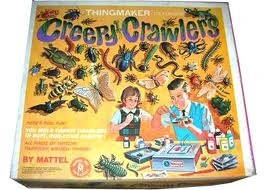
I admit I envied those. But Mom was not a fan.
Wonder why? I could have saved us a ton on gifts.
What's your favorite retro toy?
Got your eye on anything coming out at the CES?
January 9, 2012
Finding your next perfect read. It’s complicated. Part I

Sorting through all the books in the world can be like isolating a single droplet of water from a flood.
Recently my good friend, Danny, asked what it takes to become a published author.
What does that have to do with finding the perfect read you say?
Because in order for a reader to find a good book, the nugget of the idea leading to that book has been in process for…well, millennia. By an author who pictures who the audience will be.
Let’s jump ahead a bit. Hold on, you’ll see where I’m going.
First, you already know there are many good books out there. And many millions more waiting to be published. Imagine you’re standing at the bottom of the waterfall in the photo. Yeah. Millions pouring onto the market every year.
Millions, Bev?
U-yeah. With the advent of computers, it’s estimated there are over a million unpublished manuscripts. Just waiting to be discovered, published and read.
And that’s why Danny’s question made me think of readers. Because to write, to be published, a writer should first know something about his reader.
And if a writer does his homework (besides learning the craft, clicking out a great story) you, the reader, have to work to find your favorite genre, new authors in the style you enjoy, to compare similar books, read reviews, download samples…whew.
More complicated than walking into your corner bookstore or library? Yes, but it is getting easier than ever to find your next great read. Or is it?
So before I address Danny’s question, I have one for you, the reader.
Where do you find trustworthy recommendations? What’s your favorite way to find your next great read? Have you learned new ways to explore the world of books for new authors, new genres?
If so, do you share your discoveries on Facebook, at the water cooler…erm, coffee shop?
I’ll start, here are some links I follow.
http://www.goodreads.com/ Authors and readers connect, you can fill up your shelves, follow other readers and writers, and join groups with people who enjoy reading the same things you do.
Library Thing Similar to Goodreads, I’m just learning how to navigate this powerful site.
Real Simple, both the magazine and online community. Besides the book club, they do an excellent job of compiling lists, getting reader input, and letting you know what’s hot. Full disclosure, my novel, FRESH START SUMMER, made their 21 Hot Summer Reads of 2011. Booyah!
For more about the author to reader connection, I found Anne Trubek‘s blog in the New York Times, erm…eloquent. (You may have to subscribe, but when I signed in, it was free.)
In Part II, we’ll talk more about Danny’s actual question.
Finding your next perfect read. It's complicated. Part I

Sorting through all the books in the world can be like isolating a single droplet of water from a flood.
Recently my good friend, Danny, asked what it takes to become a published author.
What does that have to do with finding the perfect read you say?
Because in order for a reader to find a good book, the nugget of the idea leading to that book has been in process for…well, millennia. By an author who pictures who the audience will be.
Let's jump ahead a bit. Hold on, you'll see where I'm going.
First, you already know there are many good books out there. And many millions more waiting to be published. Imagine you're standing at the bottom of the waterfall in the photo. Yeah. Millions pouring onto the market every year.
Millions, Bev?
U-yeah. With the advent of computers, it's estimated there are over a million unpublished manuscripts. Just waiting to be discovered, published and read.
And that's why Danny's question made me think of readers. Because to write, to be published, a writer should first know something about his reader.
And if a writer does his homework (besides learning the craft, clicking out a great story) you, the reader, have to work to find your favorite genre, new authors in the style you enjoy, to compare similar books, read reviews, download samples…whew.
More complicated than walking into your corner bookstore or library? Yes, but it is getting easier than ever to find your next great read. Or is it?
So before I address Danny's question, I have one for you, the reader.
Where do you find trustworthy recommendations? What's your favorite way to find your next great read? Have you learned new ways to explore the world of books for new authors, new genres?
If so, do you share your discoveries on Facebook, at the water cooler…erm, coffee shop?
I'll start, here are some links I follow.
http://www.goodreads.com/ Authors and readers connect, you can fill up your shelves, follow other readers and writers, and join groups with people who enjoy reading the same things you do.
Library Thing Similar to Goodreads, I'm just learning how to navigate this powerful site.
Real Simple, both the magazine and online community. Besides the book club, they do an excellent job of compiling lists, getting reader input, and letting you know what's hot. Full disclosure, my novel, FRESH START SUMMER, made their 21 Hot Summer Reads of 2011. Booyah!
For more about the author to reader connection, I found Anne Trubek's blog in the New York Times, erm…eloquent. (You may have to subscribe, but when I signed in, it was free.)
In Part II, we'll talk more about Danny's actual question.
January 3, 2012
Downsizing America’s largest home
 I’m hooked on “Selling Spelling Manor” on HGTV. If you’re like me and pull out that jam packed drawer looking for scissors, then slam it shut in horror at the mess, or maybe you’re into downsizing on a larger scale, but feeling discouraged about what to do with all your stuff, consider Candy’s challenge:
I’m hooked on “Selling Spelling Manor” on HGTV. If you’re like me and pull out that jam packed drawer looking for scissors, then slam it shut in horror at the mess, or maybe you’re into downsizing on a larger scale, but feeling discouraged about what to do with all your stuff, consider Candy’s challenge:
123 rooms, 56,000 square feet (bigger than the White House), 150 original works of art (This list scratches the surface. I missed how many Madame Alexander dolls she had). Oh! There was an entire floor dedicated to closets, a full attic that looked more like a warehouse, and it took 4 moving companies to clear the home.
Feel better yet?
Have a great fresh start, Candy!
Now to tackle that junk drawer.
Downsizing America's largest home
 I'm hooked on "Selling Spelling Manor" on HGTV. If you're like me and pull out that jam packed drawer looking for scissors, then slam it shut in horror at the mess, or maybe you're into downsizing on a larger scale, but feeling discouraged about what to do with all your stuff, consider Candy's challenge:
I'm hooked on "Selling Spelling Manor" on HGTV. If you're like me and pull out that jam packed drawer looking for scissors, then slam it shut in horror at the mess, or maybe you're into downsizing on a larger scale, but feeling discouraged about what to do with all your stuff, consider Candy's challenge:
123 rooms, 56,000 square feet (bigger than the White House), 150 original works of art (This list scratches the surface. I missed how many Madame Alexander dolls she had). Oh! There was an entire floor dedicated to closets, a full attic that looked more like a warehouse, and it took 4 moving companies to clear the home.
Feel better yet?
Have a great fresh start, Candy!
Now to tackle that junk drawer.
January 2, 2012
Downsizing the largest home in America

Spelling Manor
I'm hooked on "Selling Spelling Manor" on HGTV. If you're into downsizing, clearing clutter, but feeling discouraged about what to do with all your stuff, consider Candy's challenge:
123 rooms, 56,000 square feet (bigger than the White House), 150 original works of art (I'm scratching the surface. I missed how many Madame Alexander dolls she had). Oh! There was an entire floor dedicated to closets, a full attic that looked more like a warehouse, and it took 4 moving companies to clear the home.
Feel better yet?
Have a great fresh start, Candy!


